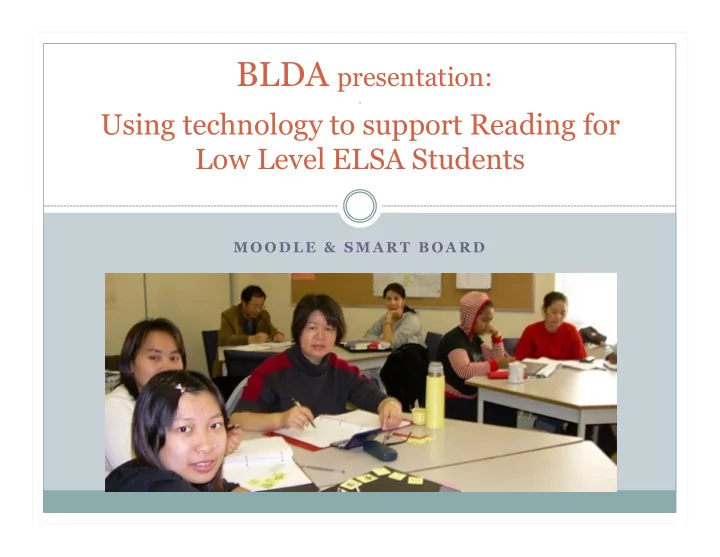

BLDA presentation: . Using technology to support Reading for Low Level ELSA Students M O O D L E & S M A R T B O A R D
MOSAIC Language Centre ELSA – English Language Services for Adults: Pre-Literacy to Level 5 Free English classes – government-funded, newcomers to Canada, ages 17+ My Role: Team Leader for Literacy to Level 3 Progress test – Ss must show CLB4 skills at L3 to progress to L4 Facilitate greater use of technology in/outside the classroom Encourage extended learning activities outside of class Create opportunity for review of lessons at home Increase digital literacy for lower level students
Puzzling Issues Student reading ability – not passing progress tests Instructors ask for more reading materials Ss would benefit from outside of class supported learning Photostory readers – http://www.grassrootsbooks.net/ca/grass-roots-readers Currently purchased, but not being used Online activities in pdf, but not SB friendly or accessible to Ss Computer lab Under-utilized – Ss need to develop digital literacy Ss require safe & secure online access SMART Boards (Interactive/electronic whiteboards) Purchased over a year ago but not being fully utilized Not all instructors adept at designing materials
PEDAGOGICAL Associative Behaviourist Situative Constructivist “…rehearsing skills and “… emphasize active concepts in a highly learning-by-doing with structured way…” immediate feedback on (Beetham, 2007, p.27) success…” APPROACH (Mayes & de Frietas, 2007, p.16) . “…models learning as the “…the essence […] the gradual building of patterns learners’ search for of associations and skill meaning through activity components” is central” (Mayes & de Frietas, 2007, p.15) (Mayes & de Frietas, 2007, p.17) . “…aggregates at the level of “Individual discovery of groups of learners, principles is heavily describing activity systems scaffolded by social in which individuals environment” . participate as members of (Beetham, 2007, p.27) communities” (Mayes & de Frietas, 2007, p.20) .
Differing perspectives… . Analysing learning at different levels of aggregation in the learning cycle: Mayes & de Frietas 2007, p.21 SITUATED SITUATED Begins with learner Checking with peers motivated by peers in and engaging in community of practice dialogue COGNITIVE Continues with ASSOCIATIVE learner deriving Mastery of task through meaning through scaffolded/sequenced understanding, activities engaged in learning activities
Design Principles for the Blend . “Central to learning is the creation of an environment particularly conducive to the area involved” (Bork 1980, p.606). Consolidation Practice Integration Flexibility across activities
Blend MOODLE SMART Board In-class activities Out-of-class activities Pre-reading activities Listen to the story Introduction Record their own reading Preview book Predict the story Vocabulary Review Post-reading activities Vocabulary linked to Miriam Webster Remembering details Learner’s Dictionary www.learnersdictionary.com/ Comprehension check Vocabulary bank Group discussion SB games Extended activities Scrambled sentences Worksheets Ordering sentences Online discussion Word/picture matching Giving/receiving advice
SMART Board – Introduction to the Story
MOODLE Sample Worksheet Ss would have access to the answer key to check their answers.
MOODLE – Outside of class activities
References Beetham, H. (2007) ‘An approach to learning activity design’, in Beetham, H. and Sharpe, R. (Eds) Rethinking Pedagogy for a Digital Age , Oxford: Routledge. Bork, A. (1980). Interactive learning. In R. Taylor (Ed.) The computer in school: Tutor, tool, tutee (pp. 53-66). New York: Teachers College Press. Available from: http://www.citejournal.org/vol2/iss4/seminal/article1.cfm [Accessed 14th December 2012] Mayes & De Freitas.(2007) ‘Learning and E-Learning: the role of theory’, in Beetham, H. and Sharpe, R. (Eds) Rethinking Pedagogy for a Digital Age , Oxford: RoutledgeFalmer. Sharma, P. & Barrett, B. (2007) Blended Learning: Using technology in and beyond the language classroom, Macmillian Education.
Recommend
More recommend